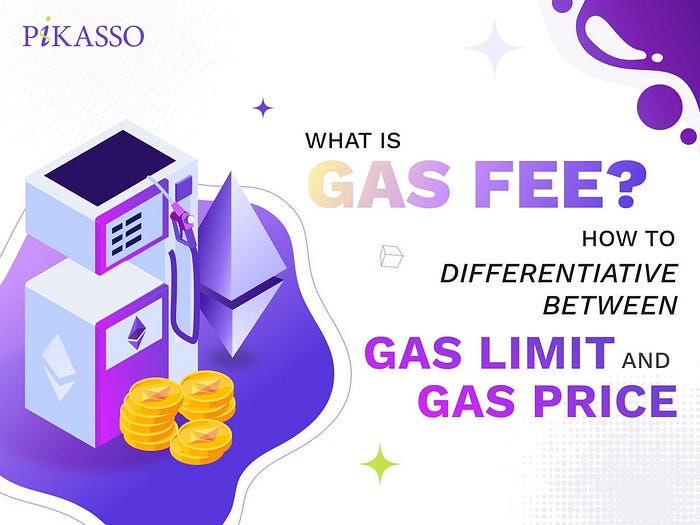What is Gas fee? How to differentiate between Gas Limit and Gas Price
A basic concept for any economic system is that all work requires compensation. In a blockchain network, computers use large amounts of electricity to compute and verify transactions. But whereas a bank charges a standard fee for a transaction set by them as the central authority, blockchain is decentralized, and has no central authority, so who figures out how much a transaction costs?

Why Do We Need Gas Fees?
The term “gas” was popularized by the Ethereum blockchain, who uses this term to represent transaction fees or miner fees, similar to the way gasoline powers an engine. Blockchains such as Ethereum operate a digital ledger of transactions distributed in a decentralized network.
Whereas a bank fee goes to the bank’s profits and operating costs, a gas fee is a way for the validators on the network to earn money for their work. This is one of the advantages of decentralized networks. Research has shown that the average bank fee is 60–70% profit, meaning that the actual sunk cost of executing the transaction is much lower than what they charge. Cryptocurrency was partially invented as a way to provide cheaper alternatives to the greedy and often monopolized banking system. Gas fees still have to provide enough incentive for miners/validators to keep the network going, but don’t suffer from the predatory transaction fees many banks force upon their customers.
What Determines the Gas Fee?
All transactions are subject to the variable gas fee that is based on the complexity of the operation needed to be performed. For example on the Ethereum blockchain, a small transfer of Ether is a cheap transaction since it involves minimal data. In contrast, a smart contract that is part of a decentralized app might require recording, storing and managing large amounts of data, which would require a higher gas fee.
The issue becomes more complicated as Crypto gains adoption. In some instances using the Ethereum blockchain would be economically invaluable and save money, whereas other transactions have shown to be completely impractical given the gas fees at certain times.
To help resolve this issue, Ethereum recently transitioned from a PoW (proof-of-work) validation system to a PoS (proof-of-stake) consensus mechanism. This means that instead of using energy intensive computing to solve complex math problems, users who stake or hold their coins on the network can be chosen by lottery to validate the next block and receive rewards. This allows the validators to work in a much more cost effective way, thus lowering gas.
Tips to Save On Gas
Understanding gas fees can be one of the most important tools for businesses entering the Web3 world, as well as investors who want to maximize their profits. Here are some important things to consider when trying to get the best gas fee possible.
Gas limit: A gas limit is the maximum amount a crypto user is willing to pay for a transaction. Often with how variable gas prices are, it can be hard to determine the exact gas fee. Setting a gas limit allows network users to send transactions and execute smart contracts with confidence they won’t be charged an exorbitant fee.
Time of day: Blockchain networks are global, but still experience variable network traffic depending on the time of day. The Ethereum blockchain can only process a certain amount of transactions every second. As such, the most high traffic times for the network can lead to high gas fees.
Layer 2 solution (ZK-rollups): Ethereum is a layer-1 blockchain. Layer-2 chains are blockchains that are then built on top of the Ethereum network. The goal of layer-2 chains is to increase transaction speed and reduce costs by rolling up the layer-2 work before sending it to the layer-1 chain to be added to the main Ethereum blockchain. Zk-rollups are scaling solutions, off-chain protocols that operate independently but derive security from Ethereum. The Ethereum network enforces the validity of state updates on the ZK-rollup and guarantees the availability of data behind every update to the rollup’s state. This allows for a scalability that means a network’s growth doesn’t automatically mean an increased gas fee.
Conclusion
Every crypto user needs to understand how the network they are using rewards the people who run the network. The advantage of decentralization is that transaction fees are usually related to traffic and energy consumption, instead of greedy bank policies that don’t reflect actual cost. Understanding and knowing how to use gas fees to your advantage is a key part of using crypto for every user; investor or creator.
About Pikasso
Pikasso is a firebase infrastructure for NFT apps and games, creating an easier way for projects to create NFT, all on low-cost layer-2 ecosystems. Pikasso saves users the time needed by using a no-code platform to create NFT, with an improved UX/UI, and marketplace generator for each NFT project, all while bridging the gap between web2 and web3 content.
